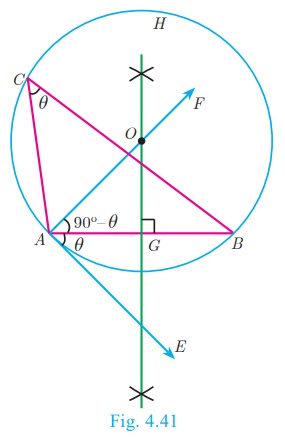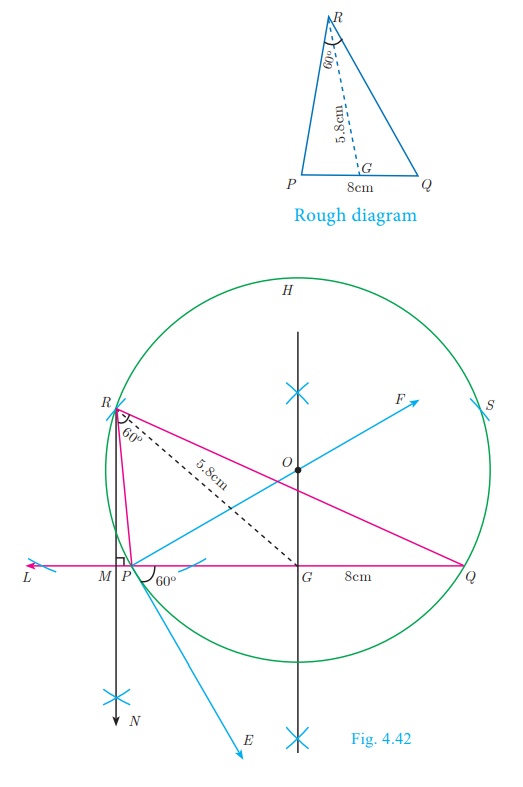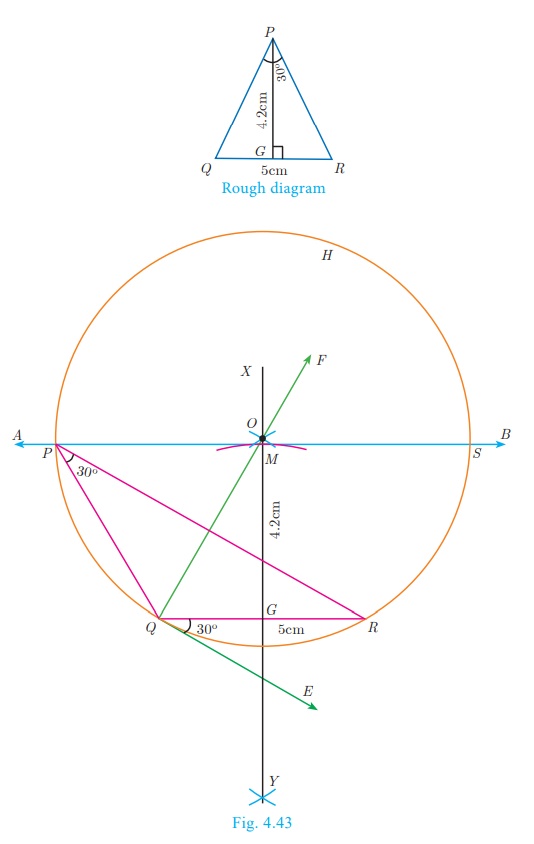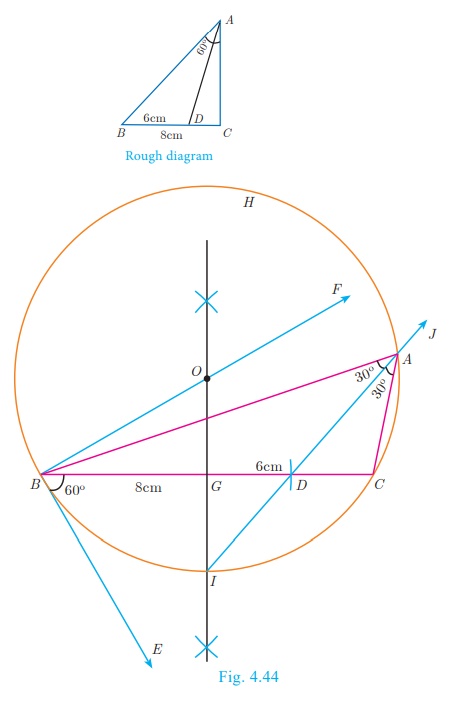Geometry | Mathematics - Construction of triangle | 10th Mathematics : UNIT 4 : Geometry
Chapter: 10th Mathematics : UNIT 4 : Geometry
Construction of triangle
Construction of triangle
We have already learnt in previous class how to construct triangles
when sides and angles are given.
In this section, let us construct a triangle when the following
are given :
(i) the base, vertical angle and the median on the base
(ii) the base, vertical angle and the altitude on the base
(iii) the base, vertical angle and the point on the base where the
bisector of the vertical angle meets the base.
First, we consider the following construction,
Construction of a segment of a circle on a given line segment
containing an angle θ
Construction
Step 1: Draw a line segment ![]()
Step 2: At A, take ∠BAE = θ Draw AE.
Step 3: Draw, AF ┴ AE .
Step 4: Draw the perpendicular bisector of AB meeting AF at
O.
Step 5: With O as centre and OA as radius draw a circle ABH.
Step 6: Take any point C on the circle, By the alternate segments
theorem, the major arc ACB is the required segment of the circle
containing the angle θ.

Note
If C 1 , C2,...
are points on the circle, then all the triangles ΔBAC 1
, ΔBAC2,... are with same base and
the same vertical angle.
Construction of a triangle when its base, the vertical angle and
the median from the vertex of the base are given.
Example 4.17
Construct a ΔPQR in which PQ = 8 cm, ∠R = 60° and the median RG from R to PQ
is 5.8 cm. Find the length of the altitude from R to PQ.
Solution

Construction
Step 1: Draw a line segment PQ = 8cm.
Step 2: At P, draw PE such that ∠QPE = 60°.
Step3: At P, draw PF such that ∠EPF = 90°.
Step 4: Draw the perpendicular bisector to PQ, which intersects PF
at O and PQ at G.
Step 5: With O as centre and OP as radius draw a circle.
Step 6: From G mark arcs of radius 5.8 cm on the circle. Mark them
as R and S .
Step 7 : Join PR and RQ. Then ΔPQR is the required
triangle.
Step 8 : From R draw a line RN perpendicular to LQ. LQ
meets RN at M
Step 9: The length of the altitude is RM = 3.5 cm.
Note
We can get another ΔPQS for the given measurements.
Construct a triangle when its base, the vertical angle and the
altitude from the vertex to the base are given.
Example 4.18
Construct a triangle ΔPQR such that QR = 5 cm, ∠P = 30° and
the altitude from P to QR is of length 4.2 cm.

Construction
Step 1 : Draw a line segment QR = 5 cm.
Step 2 : At Q draw QE such that
∠RQE = 30°.
Step 3 : At Q draw QF such that
∠EQF = 90°.
Step 4 : Draw the perpendicular bisector XY to QR
which intersects QF at O and QR
at G.
Step 5 : With O as centre and OQ as
radius draw a circle.
Step 6: From G mark an arc in the line XY at M, such
that GM = 4. 2 cm.
Step 7: Draw AB through M which
is parallel to QR.
Step 8: AB meets the circle at P and S.
Step 9: Join QP and RP. Then ΔPQR
is the required triangle.
Note
ΔSQR is another required triangle for the
given measurements.
Construct of a triangle when its base, the vertical angle and
the point on the base where the bisector of the vertical angle meets the base
Example 4.19
Draw a triangle ABC of base BC = 8 cm, ∠A = 60° and the bisector of ∠A meets BC at D such that BD = 6 cm.
Solution

Construction
Step 1 : Draw a line segment BC= 8 cm.
Step 2 : At B, draw BE such that ∠CBE = 60°
Step 3 : At B, draw BF such that ∠EBF = 90° .
Step 4 : Draw the perpendicular bisector to BC, which intersects BF
at O and BC at G.
Step 5 : With O as centre and OB as radius draw a circle.
Step 6 : From B, mark an arc of 6cm on BC at D.
Step 7 : The perpendicular bisector intersects the circle at I. Joint ID.
Step 8 : ID produced meets the circle at A. Now join AB and
AC. Then ΔABC is the required triangle.
Related Topics